IMC Networks IE-MiniFiberLinX-II Telco/Last Gasp User manual
- Category
- Network media converters
- Type
- User manual
This manual is also suitable for

IE-MiniFiberLinX-II
(Non-Telco, Telco
and Telco/Last Gasp)
Operation Manual
Above illustrations are representative; some minor differences may be present in actual product

ii
FCC Radio Frequency Interference Statement
This equipment has been tested and found to comply with the limits for a Class A computing device, pursuant to Part 15 of the FCC Rules.
These limits are designed to provide reasonable protection against harmful interference when the equipment is operated in a commercial
environment. This equipment generates, uses and can radiate radio frequency energy and, if not installed and used in accordance with the
instruction manual, may cause harmful interference to radio communications. Operation of this equipment in a residential area is likely to
cause harmful interference in which the user will be required to correct the interference at his own expense.
Any changes or modifications not expressly approved by the manufacturer could void the user’s authority to operate the equipment.
The use of non-shielded I/O cables may not guarantee compliance with FCC RFI limits. This digital apparatus does not exceed the Class A
limits for radio noise emission from digital apparatus set out in the Radio Interference Regulation of the Canadian Department of
Communications.
Le présent appareil numérique n’émet pas de bruits radioélectriques dépassant les limites applicables aux appareils numériques de classe A
prescrites dans le Règlement sur le brouillage radioélectrique publié par le ministère des Communications du Canada.
Warranty
IMC Networks warrants to the original end-user purchaser that this product, EXCLUSIVE OF SOFTWARE, shall be free
from defects in materials and workmanship under normal and proper use in accordance with IMC Networks' instructions
and directions for a period of six (6) years after the original date of purchase. This warranty is subject to the limitations set
forth below.
At its option, IMC Networks will repair or replace at no charge the product which proves to be defective within such
warranty period. This limited warranty shall not apply if the IMC Networks product has been damaged by unreasonable
use, accident, negligence, service or modification by anyone other than an authorized IMC Networks Service Technician
or by any other causes unrelated to defective materials or workmanship. Any replaced or repaired products or parts carry
a ninety (90) day warranty or the remainder of the initial warranty period, whichever is longer.
To receive in-warranty service, the defective product must be received at IMC Networks no later than the end of the
warranty period. The product must be accompanied by proof of purchase, satisfactory to IMC Networks, denoting
product serial number and purchase date, a written description of the defect and a Return Merchandise Authorization
(RMA) number issued by IMC Networks. No products will be accepted by IMC Networks which do not have an RMA
number. For an RMA number, contact IMC Networks at PHONE: (800) 624-1070 (in the U.S and Canada) or (949) 465-
3000 or FAX: (949) 465-3020. The end-user shall return the defective product to IMC Networks, freight, customs and
handling charges prepaid. End-user agrees to accept all liability for loss of or damages to the returned product during
shipment. IMC Networks shall repair or replace the returned product, at its option, and return the repaired or new
product to the end-user, freight prepaid, via method to be determined by IMC Networks. IMC Networks shall not be
liable for any costs of procurement of substitute goods, loss of profits, or any incidental, consequential, and/or special
damages of any kind resulting from a breach of any applicable express or implied warranty, breach of any obligation
arising from breach of warranty, or otherwise with respect to the manufacture and sale of any IMC Networks product,
whether or not IMC Networks has been advised of the possibility of such loss or damage.
EXCEPT FOR THE EXPRESS WARRANTY SET FORTH ABOVE, IMC NETWORKS MAKES NO OTHER WARRANTIES,
WHETHER EXPRESS OR IMPLIED, WITH RESPECT TO THIS IMC NETWORKS PRODUCT, INCLUDING WITHOUT
LIMITATION ANY SOFTWARE ASSOCIATED OR INCLUDED. IMC NETWORKS SHALL DISREGARD AND NOT BE
BOUND BY ANY REPRESENTATIONS OR WARRANTIES MADE BY ANY OTHER PERSON, INCLUDING EMPLOYEES,
DISTRIBUTORS, RESELLERS OR DEALERS OF IMC NETWORKS, WHICH ARE
INCONSISTENT WITH THE WARRANTY SET FORTH ABOVE. ALL IMPLIED WARRANTIES INCLUDING THOSE OF
MERCHANTABILITY AND FITNESS FOR A PARTICULAR PURPOSE ARE HEREBY LIMITED TO THE DURATION OF THE
EXPRESS WARRANTY STATED ABOVE.
Every reasonable effort has been made to ensure that IMC Networks product manuals and promotional materials
accurately describe IMC Networks product specifications and capabilities at the time of publication. However, because of
ongoing improvements and updating of IMC Networks products, IMC Networks cannot guarantee the accuracy of printed
materials after the date of publication and disclaims liability for changes, errors or omissions.

iii
Table of Contents
FCC Radio Frequency Interference Statement ....................................................ii
Warranty............................................................................................................ii
About the IE-MiniFiberLinX-II Non-Telco, Telco and with Telco/Last Gasp..........1
iView² Management Software ............................................................................2
Installation .........................................................................................................3
DIN Rail Mounting.............................................................................................3
Mini-Serial Port ..................................................................................................3
LED Operation...................................................................................................4
Powering Options ..............................................................................................4
Features and Configuration ................................................................................5
Auto Negotiation, Duplex Mode and Speed.......................................................5
Assigning IP Information.....................................................................................9
Configuration .....................................................................................................9
Software Configuration.....................................................................................10
Main Configuration Screen...............................................................................11
Removing Trap Destinations.............................................................................13
System Description ..........................................................................................26
Using iView
2
....................................................................................................28
Configuration File Save/Restore Function..........................................................30
Uploading a Saved Configuration File through iConfig......................................33
Uploading a Saved Configuration File through TFTP .........................................34
Product Applications ........................................................................................36
Modes of Operation.........................................................................................37
Troubleshooting ...............................................................................................40
IE-MiniFiberLinX-II Modes of Operations..........................................................41
Specifications ...................................................................................................42
Fiber Optic Cleaning Guidelines.......................................................................43
Electrostatic Discharge Precautions...................................................................43
Safety Certifications..........................................................................................44

1
About the IE-MiniFiberLinX-II Non-Telco, Telco and with Telco/Last
Gasp
The IE-MiniFiberLinX-II is an optical demarcation network interface device (CPE),
allowing fiber network operators to connect to and manage remote network
segments. Advanced networking capabilities allow operators to easily observe both
end points and the fiber link between them as a single management entity, rather
than as separate networks. No host management traffic is visible to the remote or
customer network nor is access to the customer network required, guaranteeing end-
to-end data integrity. The IE-MiniFiberLinX-II offers 802.3ah OAM (passive).
Management is also available via the copper port; see Mode One for configuration
instructions.
The IE-MiniFiberLinX-II includes one 100 Mbps fiber port (OPTICS), one 10/100
twisted pair data port (DATA), and one auxiliary Craft port for serial configuration
(with the included adapter). The twisted pair port can Auto Negotiate or be set
manually for 10 or 100 Mbps, and half or full-duplex. The optics port operates at
100 Mbps, full duplex mode only. Powering options include AC and DC power as
well as Power over Ethernet, functioning as a Powered Device (PD) compliant with
802.3af.
The IE-MiniFiberLinX-II is 802.1Q VLAN compatible, supporting a full-range of VLAN
IDs, and offering Q-in-Q tagging and a 2-tier queue for differential prioritization
(802.1p). The IE-MiniFiberLinX-II also includes the LinkLoss and FiberAlert as well as
LinkFault Pass Through (LFPT) features for troubleshooting, loopback testing
functionality, bi-directional bandwidth control, and optional protection against
Broadcast storms. IMC Networks offers a Graphical User Interface (GUI) based
element management system called iView², which runs on SNMP.
Single-strand fiber versions of the IE-MiniFiberLinX-II allow two wavelengths to share
one fiber strand — Full-Duplex data travels on different wavelengths for example,
1310 nm and 1550 nm — doubling the capacity of fiber.
The IE-MiniFiberLinX-II with Telco/Last Gasp provides support for the Last Gasp
feature. This feature alerts the end user if power to the device fails. A Trap can be
sent to indicate the down condition if Last Gasp is enabled via the CLI. Refer to the
Unit Control Settings section on page 26.
The IE-MiniFiberLinX-II w/Telco and Telco/Last Gasp, provides support for Telco
environments,
±
48 VDC.
NOTE
Unless noted otherwise, all reference to the IE-MiniFiberLinX-II in this manual are also
applicable to the IE-MiniFiberLinX-II with: Non-Telco, Telco and Telco/Last Gasp.

2
Management
The IE-MiniFiberLinX-II is capable of accepting IP-based management traffic from its
Data and/or Fiber ports. Management can be configured on either port via the
iView2 software. When connected to an iMcV-FiberLinX-II, Host-to- Remote
management is IP-less.
iView² Management Software
iView² is a network management application for IMC Networks’ intelligent
networking devices. It features a GUI, which provides network managers the ability
to monitor and control IMC Networks’ products. The application is available in
several versions including Web-Server version 3.0 and can also function as a snap-in
module for HP OpenView Network Node Manager
iView² supports the following
platforms:
•
Windows NT
•
Windows 2000
•
Windows XP
•
Windows 7
•
Windows Vista
iConfig Utility
iConfig is an in-band utility created by IMC Networks, used for SNMP configuration
for IMC Networks’ SNMP-manageable devices.
The iConfig feature allows the following to be performed:
•
Set an IP address, subnet mask and default gateway
•
Define community strings and SNMP traps
iConfig also includes an authorized IP address system and restricted access to MIB
groups which are supported by IMC Networks’ manageable devices. These extra
layers of security do not affect SNMP compatibility. iConfig can upload new versions
of the system software and new MIB information. It also includes diagnostic
capabilities for faster resolution of technical support issues.
Default Username/Password
The default user ID and password for both iConfig and Telnet are the following:
User: admin / Password:admin

3
Installation
To install the IE-MiniFiberLinX-II into a network environment, connect the proper
twisted-pair and fiber cables. In a standalone configuration, or if direct management
is desired, assign an IP Address to the IE-MiniFiberLinX-II after installation. Refer to
Assigning IP Information for information on assigning an IP Address.
NOTE
Since single-strand fiber products use optics that transmit and receive on two different
wavelengths, single-strand fiber products must be deployed in pairs or connected with two
compatible IMC Networks single-strand fiber products. For example, connect IE-MiniFiberLinX-
II, TX/SSFX-SM1310-SC (which has 1310 xmt and 1550 rcv) to a product which has 1550 xmt
and 1310 rcv, e.g. iMcV-FiberLinX-II, TX/SSFX-SM1550-SC. The two connected products must
also have the same speed and distance capabilities (i.e. both are single-mode [20 km] or both
are single/PLUS [40 km]).
The unit shall be installed in a Restricted Access Location when installed for use in a
Tma above 50°C.
DIN Rail Mounting
The IE-MiniFiberLinX-II can be mounted with two DIN Rail clips, a hardware option
available through IMC Networks. The DIN Rail clips include screws, to allow the
installation onto a DIN Rail. Install the screws into DIN Rail clips, which should be
mounted perpendicular to the DIN Rail. Snap the converter onto the clips. To
remove the converter from the DIN Rail, use a flat-head screwdriver into the slot to
gently pry the converter from the rail.
Autocross Feature for Twisted Pair Connection
All twisted pair ports on the IE-MiniFiberLinX-II include AutoCross, feature that
automatically selects between a crossover workstation and a straight-through
connection depending on the connected device.
Mini-Serial Port
Included with the IE-MiniFiberLinX-II is a serial port adapter for configuration.
A standard AC mini-jack on the IE-MiniFiberLinX-II provides a local RS-232, Craft
interface for management. A special mini-jack to DF-9F cable is provided for direct
connection to a PC serial port.
NOTE
To log on through the serial port, set the computer/terminal for VT-100 emulation, with; 38.4K
baud, 8 data bits, 1 stop bit, no parity, no FlowControl.

4
LED Operation
The IE-MiniFiberLinX-II features two diagnostic LEDs:
FX LNK/ACT This LED is on when a FX Link exists and blinks when data passes
through the fiber connection.
TX LNK/ACT This LED is on when a TX Link exists and blinks when data passes
through the twisted-pair connection.
Powering Options
The IE-MiniFiberLinX-II powering options include AC and DC power as well as Power
over Ethernet, functioning as a PD compliant with 802.3af. The DC Terminal block
allows you to daisy-chain one IE-MiniFiberLinX-II to another. To use the DC terminal
block, connect to any one positive and any one negative terminal from a power
source. The illustration shows the wiring configurations for the DC terminal block (12
to 48 VDC).
Non-Telco Version
Telco Version
NOTE
For Telco Only: It does not matter which terminal is referenced (connected to) earth-
ground. For example, when using a -48 VDC supply in which the positive rail is
connected to earth-ground, simply connect this side to a terminal block “+” terminal
and the -48 VDC side to the negative terminals.
+5 to 24 VDC
12 to 48 VDC 7 to 50 VDC
+5 to 24 VDC

5
CAUTION: This equipment is designed to permit the connection of the grounded
conductor of the DC supply circuit to the grounding conductor at the equipment.
If this connection is made, all of the following conditions must be met:
•
This equipment shall be connected directly to the DC supply system grounding
electrode conductor or to a bonding jumper from a grounding terminal bar or
bus to which the DC supply system grounding electrode conductor is connected.
•
This equipment shall be located in the same immediate area (such as, adjacent
cabinets) as any other equipment that has a connection between the grounded
conductor of the same DC supply circuit and the grounding conductor, and also
the point of grounding of the DC system. The DC system shall not be grounded
elsewhere.
•
The DC supply source is to be located within the same premises as the
equipment.
•
Switching or disconnecting devices shall not be in the grounded circuit
conductor between the DC source and the point of connection of the grounding
electrode conductor.
•
When powering the unit via the Power-Over-Ethernet option (i.e. using DC
power provided over an Ethernet cable connected to the Ethernet port), do not
connect any other power source (cables) to the unit even if the power is in the
off state. This is to maintain isolation as called out in the 802.3af and 802.3at
specifications.
Features and Configuration
The IE-MiniFiberLinX-II offers a full feature set including Auto Negotiation, Selective
Advertising, FiberAlert, AutoCross, read/write VLANs, SNMP management, bandwidth
control, and loopback testing. Features can be configured through software or via a
serial port, Telnet session, iConfig or SNMP.
Unit software updates can be downloaded through TFTP and iConfig.
Auto Negotiation, Duplex Mode and Speed
The twisted pair port on the IE-MiniFiberLinX-II Auto Negotiates for speed and
duplex mode. The optics port does not Auto Negotiate; it operates at 100 Mbps Full-
Duplex. Use the management software to configure the features on the twisted pair
ports.

6
The IE-MiniFiberLinX-II ships from the factory with Auto Negotiation enabled on the
twisted pair port. In this mode, the port automatically negotiates for speed and
duplex.
The twisted pair port on the IE-MiniFiberLinX-II can also be manually set for 10 Mbps
or 100 Mbps operation and for Half- or Full-Duplex (i.e. 10 Mbps Full-Duplex, 10
Mbps Half-Duplex, 100 Mbps Full-Duplex or 100 Mbps Half-Duplex).
Selective Advertising, when used in combination with Auto Negotiation, advertises
only the configured speed and duplex mode for the twisted pair port. If a specific
speed and/or duplex mode is desired, Selective Advertising should be used rather
than Force Mode, when connecting to devices that ONLY Auto Negotiate.
Bandwidth Control
The IE-MiniFiberLinX-II includes bi-directional bandwidth control, which can be
independently set in 32 Kbps increments up to 100 Mbps. Bandwidth control can be
configured through iView² or a console session. The device features an integrating
algorithm with a 64 Kb buffer, allows traffic bursts, to prevent lost data.
This allows
operators to offer tiered services. See the iView² for configuration information.
FX LinkLoss, TX LinkLoss and FiberAlert
During normal operation, link integrity pulses are transmitted by all point-to-point
Ethernet devices. When an IE-MiniFiberLinX-II receives valid link pulses, it knows the
device to which it is connected is up, and the copper or fiber cable coming from that
device is intact. The appropriate link LED is lit to indicate this. For troubleshooting
information using the LinkLoss and FiberAlert features of the IE-MiniFiberLinX-II
modules, refer to the Troubleshooting section of this manual.
WARNING
The FiberAlert and LinkLoss features cause data interruptions designed to alert remote sites of
line failures. These data interruptions can be misinterpreted as module failures if these features
are not enabled properly. Enable these features only when the resulting data interruptions and
causes are well understood.
FX LinkLoss
FX LinkLoss is link integrity monitoring feature that forwards fiber link faults to the RJ-
45 DATA port to indicate that a fiber link fault has occurred.
TX LinkLoss
TX LinkLoss is a link integrity monitoring feature that forwards an RJ-45 link fault to
the fiber connected device to indicate that a link fault has occurred.

7
FiberAlert
FiberAlert minimizes the problems associated with the loss of one strand of fiber.
Normally when a single strand of fiber is lost, the transmitting side of the connection
is unaware that there is a fault. FiberAlert returns faults back on the fiber they came
in on.
Using LinkLoss and FiberAlert
In a typical central site to remote site media conversion, it is recommended the
LinkLoss and FiberAlert features are enabled as indicated in the following:
FiberAlert and LinkLoss
Feature Enabled Fault Location Port Affected
FiberAlert Remote Side Only Fiber Fiber
TX LinkLoss Remote Side (or both) Twisted Pair Fiber
FX LinkLoss Host Side (or both) Fiber Twisted Pair
WARNING
Do not enable FiberAlert on both modules when using them in pairs. This will cause them to
lock up when a fault occurs on the fiber. Only enable FiberAlert on the remote module.
Link Fault Pass Through (LFPT)
Link Fault Pass-Through (LFPT) is a troubleshooting feature that combines TX and FX
LinkLoss from both the local and remote IE-MiniFiberLinX-II. LFPT is enabled by
turning on both FX and TX LinkLoss on both modules. This feature allows either end
of the conversion to detect a link fault occurring at the other end of the media
conversion chain.
Regardless if there is a break in segment 1, 2 or 3, the link will drop on the switches
at both ends. The link fault is passed through the media conversion and is observed at
each end. It acts just like it would if the devices were directly connected.

8
Loopback Testing
The IE-MiniFiberLinX-II includes Loopback testing functionality. During loopback
testing, management traffic entering the uplink port is still capable of managing the
device. This is selectable form the UNIT screen in a serial/Telnet session or through
iView².
The menu of choices in the CLI includes:
•
No loopback, normal traffic mode
•
Loopback Enabled
•
Loopback, Source/Destination address swap
•
Loopback, address swap and clear Multicast bit
•
No learning on fiber or Data ports
The menu of choices in iView² includes:
•
Off
•
ON
•
On- Address Swap
•
On-Address swap + Clear MC
Loopback Testing on Remote or Standalone
No loopback, normal traffic mode
The standard mode in which the units function, either as stand-alone or
Host/Remote.
Loopback Enabled
Loopback mode without address swap
Loopback, Source/Destination Address Swap
A Layer 2 Ethernet switch will discard all received packets with the same MAC
address as sent packets. To avoid this issue the Loopback feature can swap the
source and destination MAC addresses on the looped data. (This selection can cause
a frame with a multicast source address to be created, which violates the IEEE
standard.)
Loopback, Address Swap and Clear Multicast Bit
In addition to swapping the source and destination MAC addresses on the looped
data, the Loopback feature can also be set to clear the multicast bit. This allows the
looped data to avoid being blocked by any multicast settings.
Loopback Testing in a Host/Remote configuration

9
The IE-MiniFiberLinX-II is strictly a CPE device; configuration on a Host would require
an iMcV-FiberLinX-II; select No Learning on OPTICS and DATA Ports on the Host; on
the Remote, choose SRC/DST Address Swap or Address Swap and Clear Multicast Bit.
Host: No Learning on OPTICS and DATA Ports
The Loopback feature can be set to disable address learning on the OPTICS (or
UPLINK) and DATA ports, allowing the loopback to be performed without
interference from MAC address filtering functions. This is a function on the HOST
unit. Set the REMOTE unit for Loopback then set the HOST to disable learning so
Loopback frames pass from the OPTICS port to the DATA port.
Remote: Source/Destination Address Swap
A Layer 2 Ethernet switch will discard all received packets with the same MAC
address as sent packets. To avoid this issue the Loopback feature can swap the
source and destination MAC addresses on the looped data.
OR
Address Swap and Clear Multicast Bit
In addition to swapping the source and destination MAC addresses on the looped
data, the Loopback feature can also be set to clear the multicast bit. This allows the
looped data to avoid being blocked by any multicast settings.
NOTE
Units should not be in the Default Mode when performing LoopBack tests.
Assigning IP Information
To utilize SNMP-management in a standalone environment, the IE-MiniFiberLinX-II
IP configuration information (e.g., IP address, subnet mask, etc.) must be assigned by
using iConfig (from iView²), by using the unit’s serial port or by using DHCP.
These methods will also allow you to create community strings, assign access rights,
configure traps and more. iConfig offers more options than serial port configuration.
After assigning the IE-MiniFiberLinX-II an IP address, use iView² or another SNMP-
compatible Network Management System (NMS) for remote configuration,
monitoring and management.
Configuration
The IE-MiniFiberLinX-II includes many features that function automatically or are
configurable via iView², iConfig, or a serial/Telnet session.

10
Software Configuration
The following table presents port options configurable from iView² or from a
serial/Telnet session. Refer to the iView² section later in this chapter or the iView²
Help file for more information. For information on configuring VLANs, refer to the
Serial Configuration/Telnet Session section in this chapter.
Feature iView² Serial/Telnet
FX/TX LinkLoss
9
9
FiberAlert
9
9
Loopback
9
9
Auto Negotiation
9
9
Selective Advertising
9
9
Force Mode
9
9
FlowControl
9
9
Bandwidth Control
9
9
VLANs
9
Last Gasp (Telco /LastGasp model only
9
The following table presents management options configurable via iConfig or a
serial/Telnet session.
Feature iView² Serial/Telnet
PROM Software Download/Upload
9
Telnet Session
9
TFTP Trigger
9
Software Download Setup (TFTP)
9
DHCP
9
Configuration File/Save Restore
9
The following options are configurable through both iConfig and Serial:
•
IP Address
•
Subnet Mask
•
Default Gateway
•
MIB Community
•
Traps Assignment
•
Users
•
Passwords
•
Access Level
•
Reboot

11
Main Configuration Screen
Press
Enter
, at the prompt, to display the main configuration screen.
The following displays are available:
Saved Values (displays changes made during current session)
•
IP Address (must be assigned during initial configuration)
•
Subnet Mask (must be assigned during initial configuration)
•
Default Gateway (default router for IP traffic outside subnet)
•
Server IP Addr (for the TFTP server)
•
New Prom File (firmware file name)
Current Values (displays values currently in use)
•
IP Address (IP address of SNMP agent)
•
Subnet Mask (mask to define IP subnet)
•
Default Gateway (default router for IP traffic outside subnet)
•
Server IP Addr (for the TFTP server)
•
New Prom File (firmware file name)
NOTE
Reboot the IE-MiniFiberLinX-II for changes to take effect. To reboot, type
reboot
at the prompt
on the main configuration screen, or power cycle the chassis. If a
Delete
key is not available,
use the
F2
key. Any changes to the configuration may result in a momentary loss of connection.

12
Command List
I
= Enter New Saved Parameter Values
P
= Change Password
T
= New Trap Destination
K
= Remove ALL Trap Destinations
C
= New Community String
U
= Delete ALL Community Strings
E
= End Session
Reboot
= Reboots the IE-MiniFiberLinX-II
D
= Enable/disable DHCP
Space Bar
= Opens the Device Specific Configuration Options
Assigning TCP/IP Information
To modify the Saved Parameter Values (i.e., assign IP address and subnet mask), and
press
I
. Then, enter the IP address and subnet mask for the connected device,
pressing
Enter
after each. A default gateway can also be assigned, or press
Enter
to
skip. When finished, press
Enter
, then type
reboot
for changes to take effect. The
Current Values can only be saved and acted on after the IE-MiniFiberLinX-II has been
successfully rebooted.
Password Protection for Serial Port Connections
Password protection is provided for the serial configuration process by pressing
P
on
the main configuration screen. Enter a password, keeping in mind that passwords are
case-sensitive and must not exceed eight characters or include spaces, and press
Enter
. This password will be requested whenever logging on. To remove password
protection, select
P
and, instead of entering a password, press
Enter
. If a password
becomes lost, contact
IMC Networks Technical Support at (949) 465-3000 or (800)
624-1070.
Assigning Trap Destinations
Traps are sent by the manageable device to a management PC when a certain event
takes place. To enter a trap destination, press
T
. At the “Enter a New IP Address.”
prompt, enter the appropriate IP address and press
Enter
. Then, type the name of
the community string (that the destination device has been configured to accept) and
press
Enter
. This function enables ALL of the device traps. To individually activate
and deactivate traps, use iConfig for configuration. Supported traps include: Link
Down, Link Up, Cold Start, Warm Start and Authentication Failure.

13
Removing Trap Destinations
To remove all trap destinations, press
K
. Press
Y
to continue to confirm or
N
to abort
and then, press
Enter
. To selectively remove community strings, use iConfig to
configure the device.
Creating Community Strings
Community strings add a level of security to a network. The default community string
is named “public” and has read/write access. “Public” should be replaced with
custom community strings such as one with read-only access (for general use), the
other with read/write access (for the administrator).
Steps:
1.
Type
C
on the main configuration screen.
2.
Enter the name of the new community (up to 16 characters, no spaces) and
press
Enter
.
3.
Type one of the following to assign the community string’s access rights:
R
= read-only access
W
= read/write access
Enter
= abort
4.
After entering
R
or
W
, press
Enter
.
5.
To finish, press
Enter
, and reboot.
Deleting Community Strings
To delete all community strings, perform the following:
1.
Press
U
. The “
Are you sure you want to delete all future strings?
” prompt
displays.
2.
Press
Y
to proceed,
N
to abort.
3.
Press
Enter
.
This function will delete ALL community strings. To selectively delete community
strings, use iConfig to configure the device.
Ending the Session
Be sure to press
E
to end a serial port or Telnet/HyperTerminal session, before
disconnecting the cable. This will stop the continuous stream of data to the serial
port.

14
Rebooting the Unit
To reboot the IE-MiniFiberLinX-II, type
reboot
.
Enabling/Disabling DHCP
To toggle DHCP on the IE-MiniFiberLinX-II between enable and disable, press
D
.
Additional Device-Specific Commands
The IE-MiniFiberLinX-II also includes the following device-specific options.
To access these options, perform the following:
1.
Press the
Space Bar
when in the Command List section of the Main
Configuration screen (serial configuration/Telnet session).
2.
Type the name of the action (shown below) and press
Enter
.
cleandb
Reboots the unit with a clean database. This removes all information
from the database and sets the unit to factory defaults.
download
Downloads firmware via the TFTP protocol
ifStats
Displays Ethernet statistics
rmStats
Displays RMON statistics
version
Displays the unit’s serial number and build date
reboot
Reboots the unit and clears all internal counters.
security
Allows ARP request configuration. This setting is only for very unique
configurations and should not be adjusted.
port
Displays and changes port settings, such as duplex status and speed.

15
config
Allows VLAN and transparency mode configurations.
accounts
Allows the addition of new users.
sysdescr
Allows the editing of sysName, sysDescr, and Port information
text.
unit
Unit Global Setting
bw
Bandwidth Limiting Controls
sfpstats
Provides information about the wavelength, serial number, output
power, BER, and other useful information.
Last Gasp*
The Last Gasp feature sends a trap down when the power module
fails.
*
Refer to the Unit Control Settings section on page 26.
Cleandb
Entering cleandb reboots the unit with its database cleaned depending on the option
selected. Users are presented with two, sequential options, first to reset all SNMP
settings and, second, to reset all of the unit’s configuration to default. Enabling the
first option presents the second. Resetting the unit to factory default values (option
two) will delete all custom IP and VLAN settings.
Downloading Files
Firmware for the IE-MiniFiberLinX-II can be downloaded from a central server via
TFTP protocol. Initiate this download via serial configuration or Telnet session. To
download a file, type
download
and press
Enter
to be taken to the Download a file
screen. This screen displays the IP Address of the TFTP server and the name of the
file to be downloaded. The TFTP server should be open. Make sure the IP Address
and the name of the file are correct in the Current Values section of the Main
Configuration screen. These are changed by entering
I
from the Main Configuration
screen. Press
Enter
to start downloading the file.
Viewing Port Statistics
To view port statistics on the IE-MiniFiberLinX-II, enter ifstats. This will open a screen
displaying information on packets received and transmitted as defined by MIB-II
standard RFC 1213.
Pressing the
Space Bar
will refresh the data on the screen.

16
Viewing Port RMON Statistics
To view port RMON (Remote MONitoring) statistics on the IE-MiniFiberLinX-II, enter
rmstats. This will display RMON information on packets received as defined in RFC
2819 for RMON.
Pressing the
Space Bar
will refresh the data on the screen.

17
Version
Entering
version
will display the version of the firmware operating the IE-
MiniFiberLinX-II.
NOTE
In the examples shown, ports are referred to as how they appear on the unit itself. Some
screens may show TX and FX for the port titles. In this case, TX = DATA port and FX = OPTICS
port.
Reboot
Entering reboot will save settings and reboot the IE-MiniFiberLinX-II.
Setting Security
Security settings on the IE-MiniFiberLinX-II are reserved for non-standard
configurations. Most users won’t utilize this screen. Security configuration should
only be utilized when non-standard networking equipment is being employed. Enter
Y
to set new security settings or any other key to abort.
The next screen that appears will configure ARP settings, such as the destination
address of ARP messages along with Ethernet Types. Enter the new data, then press
S
to save the settings or
Q
to quit.
Port Configuration
Serial/Telnet sessions display port status as well as allowing configuration of some port
features. Type
port
and press
Enter
to be taken to the Port screen. From this screen,
view the port speed, duplex and link status.
The Port screen contains the following commands:
Port Enable
Enable/Disable the port. (Select Enable to enable the port.)
Admin Status
Set Administration level. (Select UP to enable the port.)
Both settings must be enabled to enable the port.
Port Speed
Ctrl
Set the port manually or for Auto Negotiation.
Advertise Ctrl
This is the Selective Advertising feature. Selective Advertising,
when used in combination with Auto Negotiation, advertises the
configured speed and duplex mode for the twisted pair ports.
Auto Negotiation must be enabled for Selective Advertising.
Page is loading ...
Page is loading ...
Page is loading ...
Page is loading ...
Page is loading ...
Page is loading ...
Page is loading ...
Page is loading ...
Page is loading ...
Page is loading ...
Page is loading ...
Page is loading ...
Page is loading ...
Page is loading ...
Page is loading ...
Page is loading ...
Page is loading ...
Page is loading ...
Page is loading ...
Page is loading ...
Page is loading ...
Page is loading ...
Page is loading ...
Page is loading ...
Page is loading ...
Page is loading ...
Page is loading ...
Page is loading ...
-
 1
1
-
 2
2
-
 3
3
-
 4
4
-
 5
5
-
 6
6
-
 7
7
-
 8
8
-
 9
9
-
 10
10
-
 11
11
-
 12
12
-
 13
13
-
 14
14
-
 15
15
-
 16
16
-
 17
17
-
 18
18
-
 19
19
-
 20
20
-
 21
21
-
 22
22
-
 23
23
-
 24
24
-
 25
25
-
 26
26
-
 27
27
-
 28
28
-
 29
29
-
 30
30
-
 31
31
-
 32
32
-
 33
33
-
 34
34
-
 35
35
-
 36
36
-
 37
37
-
 38
38
-
 39
39
-
 40
40
-
 41
41
-
 42
42
-
 43
43
-
 44
44
-
 45
45
-
 46
46
-
 47
47
-
 48
48
IMC Networks IE-MiniFiberLinX-II Telco/Last Gasp User manual
- Category
- Network media converters
- Type
- User manual
- This manual is also suitable for
Ask a question and I''ll find the answer in the document
Finding information in a document is now easier with AI
Related papers
-
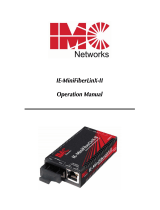 IMC Networks IE-MiniFiberLinX-II Operating instructions
IMC Networks IE-MiniFiberLinX-II Operating instructions
-
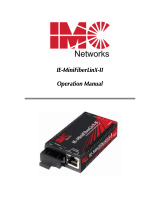 IMC Networks IE-MiniFiberLinX-II, TP-TX/FX-MM1300-ST User manual
IMC Networks IE-MiniFiberLinX-II, TP-TX/FX-MM1300-ST User manual
-
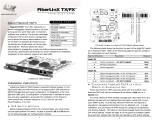 IMC Networks iMcV-FiberLinX, TX/SSFX-SM1550/PLUS-SC Installation guide
IMC Networks iMcV-FiberLinX, TX/SSFX-SM1550/PLUS-SC Installation guide
-
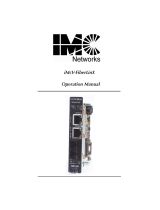 IMC Networks iMcV-FiberLinX Operating instructions
IMC Networks iMcV-FiberLinX Operating instructions
-
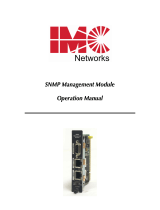 IMC Networks Management Module SNMP User manual
IMC Networks Management Module SNMP User manual
-
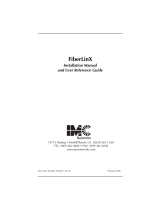 IMC Networks FiberLinX User manual
IMC Networks FiberLinX User manual
-
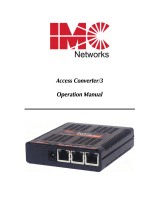 IMC Networks AccessConverter, TX/3 + SSFX-SM1310/PLUS-SC User manual
IMC Networks AccessConverter, TX/3 + SSFX-SM1310/PLUS-SC User manual
-
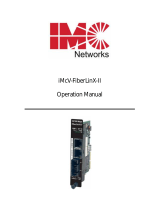 IMC Networks iMcV-FiberLinX-II Operating instructions
IMC Networks iMcV-FiberLinX-II Operating instructions
-
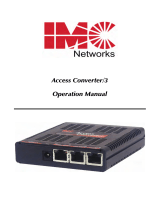 IMC Networks AccessConverter, TX/3 + SSFX-SM1310/PLUS-SC User manual
IMC Networks AccessConverter, TX/3 + SSFX-SM1310/PLUS-SC User manual
-
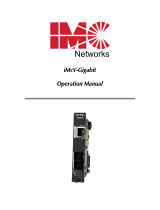 IMC Networks iMcV-Gigabit User manual
IMC Networks iMcV-Gigabit User manual
Other documents
-
IVIEW LJ-738 User manual
-
Advantech B+B SmartWorx IE-MiniFiberLinX-II Series Quick start guide
-
Black Box LHC006A User manual
-
MiLAN Raven MIL-RCM16D User manual
-
3com Intelligent Management Center Installation guide
-
Black Box LGC340A Specification
-
Intellisystem IT-PMC-1100M Owner's manual
-
LevelOne IEC-1800 Installation guide
-
LevelOne IEC-1800 Installation guide
-
IVIEW IVIEW-S100 User manual

























































